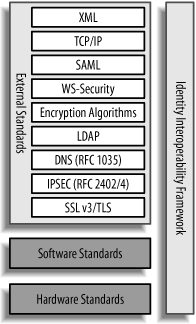Contents of an Identity IF
As shown in Figure 17-1, an IF contains three primary kinds of standards:
- External standards
Examples might be the kinds of XML standards, such as SAML, that we discussed in Chapter 11.
- Software standards
These are software choices that the organization has made. An example might be a decision to support MySQL or Linux.
- Hardware standards
These are specific hardware choices that affect interoperability. The organization may set some hardware standards strictly as a purchasing decision. Those would not typically be included in the IF. Inclusion in the IF should be done on the basis of interoperability benefits rather than purchasing power or efficiency.
Each of these may be broken into subareas, as necessary, and in each subarea choices are enumerated and documented. In addition to sections enumerating standards, an introductory section should contain the following information:

Figure 17-1. An interoperability framework provides the foundation for the policy stack
- Guidelines for use
This section describes how the document is to be used.
- Governance
This section describes the governance procedure that created the IF and how the IF can be changed. This section also describes the review cycle for the overall document.
- Application
This section describes the scope of the IF and where it should be applied.
- Exemptions
This section enumerates any global exemptions ...
Get Digital Identity now with the O’Reilly learning platform.
O’Reilly members experience books, live events, courses curated by job role, and more from O’Reilly and nearly 200 top publishers.

